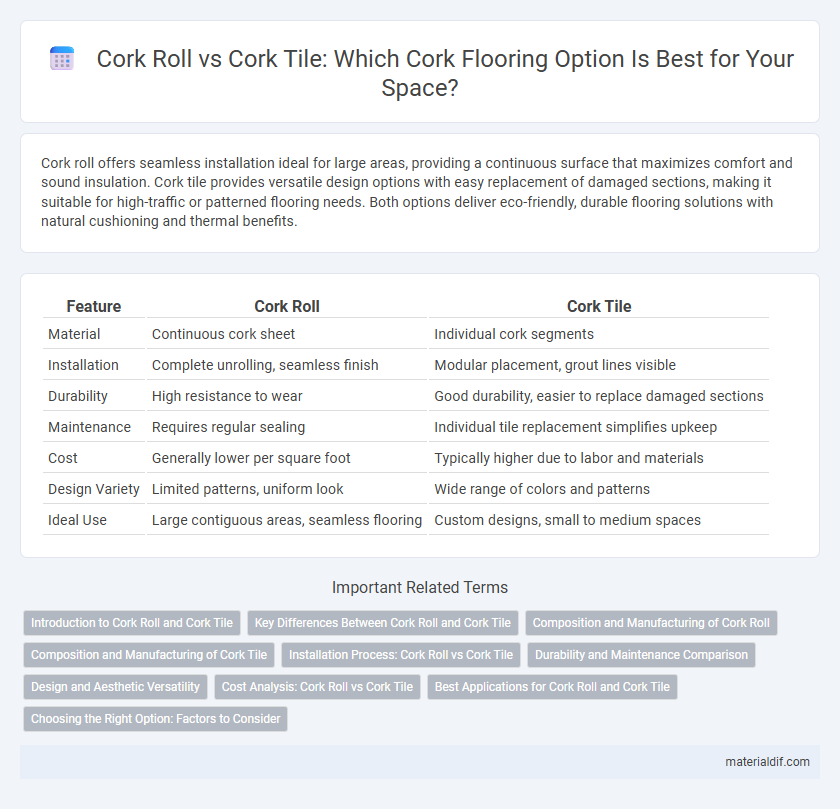Cork roll offers seamless installation ideal for large areas, providing a continuous surface that maximizes comfort and sound insulation. Cork tile provides versatile design options with easy replacement of damaged sections, making it suitable for high-traffic or patterned flooring needs. Both options deliver eco-friendly, durable flooring solutions with natural cushioning and thermal benefits.
Table of Comparison
| Feature | Cork Roll | Cork Tile |
|---|---|---|
| Material | Continuous cork sheet | Individual cork segments |
| Installation | Complete unrolling, seamless finish | Modular placement, grout lines visible |
| Durability | High resistance to wear | Good durability, easier to replace damaged sections |
| Maintenance | Requires regular sealing | Individual tile replacement simplifies upkeep |
| Cost | Generally lower per square foot | Typically higher due to labor and materials |
| Design Variety | Limited patterns, uniform look | Wide range of colors and patterns |
| Ideal Use | Large contiguous areas, seamless flooring | Custom designs, small to medium spaces |
Introduction to Cork Roll and Cork Tile
Cork roll and cork tile are two popular formats of cork flooring, each offering unique benefits for different applications. Cork roll is a continuous sheet ideal for seamless coverage and moisture resistance, making it suitable for large areas and commercial spaces. Cork tile provides modularity and design flexibility, allowing for easy replacement and varied patterns in residential and smaller-scale installations.
Key Differences Between Cork Roll and Cork Tile
Cork roll offers seamless coverage, ideal for large, irregularly shaped areas, while cork tiles provide modular installation, simplifying repairs and replacements. Cork tiles often feature more intricate patterns and thicker insulation options compared to the thinner, flexible cork roll. Both materials deliver natural soundproofing and thermal properties, but selection depends on project scale and aesthetic preferences.
Composition and Manufacturing of Cork Roll
Cork roll consists of thin, flexible sheets made by compressing natural cork granules with a resin binder, allowing for seamless installation over large areas. The manufacturing process involves grinding cork bark into granules, blending them with adhesives, and hot-pressing into rolls, which provides superior elasticity and cushioning compared to cork tiles. In contrast, cork tiles are pre-cut, rigid sections typically produced by compressing larger cork pieces, resulting in firmer, more structured flooring options.
Composition and Manufacturing of Cork Tile
Cork tiles are composed of compressed granulated cork bound with polyurethane or resin, resulting in a rigid, dense structure ideal for flooring applications. The manufacturing process involves grinding cork into granules, blending with binders, then pressing and baking the mixture into uniform, durable tiles. This contrasts with cork rolls, which are typically made from thin sheets of natural cork bark layered and glued together for flexibility rather than rigidity.
Installation Process: Cork Roll vs Cork Tile
Cork roll installation involves unrolling the seamless material directly onto a prepared subfloor, often requiring adhesive and careful smoothing to avoid bubbles, enabling a continuous, gap-free surface ideal for large areas. Cork tiles, typically smaller and modular, are laid individually, allowing easier handling and replacement, with installation methods including glue-down or floating floor systems that offer more flexibility for repairs or design patterns. Both options demand a clean, dry subfloor, but tiles provide more installation precision, while rolls offer quicker coverage for expansive spaces.
Durability and Maintenance Comparison
Cork roll offers a seamless surface that reduces wear points, enhancing overall durability compared to individual cork tiles, which can experience edge lifting or separation over time. Maintenance for cork roll is typically simpler, requiring fewer repairs and less frequent resealing due to its continuous application, while cork tiles demand regular inspection of grout lines and edges to prevent moisture infiltration. Both options benefit from routine cleaning and protective finishes, but cork roll's uniform structure tends to resist damage and maintain appearance longer under heavy foot traffic.
Design and Aesthetic Versatility
Cork roll offers a seamless, continuous surface ideal for large, uniform spaces, providing a sleek and modern aesthetic with fewer visible joints. Cork tile allows for intricate patterns and customized layouts, enhancing design flexibility and enabling unique visual compositions that adapt to various interior styles. Both materials incorporate natural cork textures and warm tones, contributing to versatile design palettes for residential and commercial environments.
Cost Analysis: Cork Roll vs Cork Tile
Cork roll typically offers lower upfront costs compared to cork tiles due to its continuous sheet format, reducing labor time and waste during installation. Cork tiles may incur higher expenses from individual placement and potential additional adhesives, but they allow for easier replacement and customization. Life cycle cost analysis shows cork roll's seamless application often reduces long-term maintenance, while cork tiles provide flexibility that can minimize future repair costs.
Best Applications for Cork Roll and Cork Tile
Cork roll offers flexibility and seamless coverage, making it ideal for large, irregularly shaped areas like yoga studios, gyms, and underlayment for flooring due to its cushioning and sound-absorbing properties. Cork tile provides modular installation, perfect for smaller spaces such as office rooms, kitchens, and accent walls, allowing easy replacement and design customization. Both options enhance thermal insulation and eco-friendly flooring solutions, but cork tile is preferred for precise patterns while cork roll excels in continuous, durable surfaces.
Choosing the Right Option: Factors to Consider
When deciding between Cork Roll and Cork Tile for flooring, consider factors such as installation ease, durability, and design flexibility. Cork Rolls offer seamless, water-resistant surfaces ideal for large spaces, while Cork Tiles provide customizable patterns and simpler replacement options. Evaluate the specific use case, budget, and maintenance preferences to choose the best fit for Cork homes and commercial areas.
Cork Roll vs Cork Tile Infographic

 materialdif.com
materialdif.com